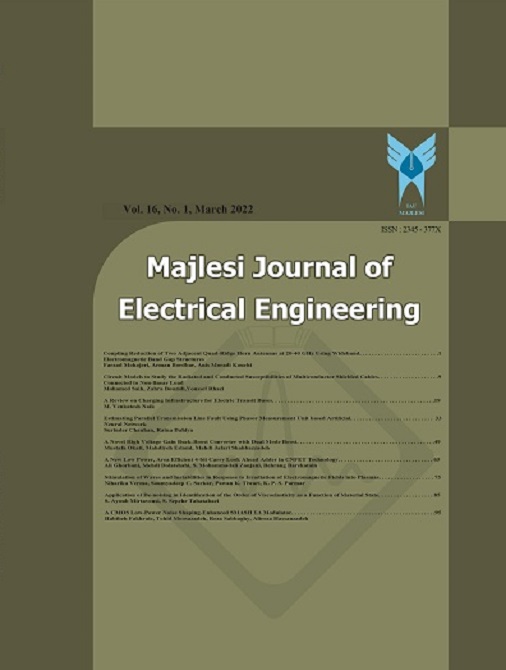[1] M. U. Saleem, M. A. Usman, and M. R. Usman, “Design, Deployment and Performance Evaluation of an IoT Based Smart Energy Management System for Demand Side Management in Smart Grid,” IEEE Access, vol. 10, pp. 15261–15278, 2022, doi: 10.1109/ACCESS.2022.3147484.
[2] T. Gould, “India Energy Outlook 2021,” 2021. doi: 10.1787/ec2fd78d-en.
[3] I. Diahovchenko, M. Kolcun, Z. Čonka, V. Savkiv, and R. Mykhailyshyn, “Progress and Challenges in Smart Grids: Distributed Generation, Smart Metering, Energy Storage and Smart Loads,” Iranian Journal of Science and Technology - Transactions of Electrical Engineering, vol. 44, no. 4, pp. 1319–1333, Dec. 2020, doi: 10.1007/S40998-020-00322-8/METRICS.
[4] Khullar Sindhushree, “Report of the Expert Group on 175 GW RE by 2022,” New Delhi, 2023. [Online]. Available: https://www.niti.gov.in/sites/default/files/energy/175-GW-Renewable-Energy.pdf
[5] A. Singh and I. S. G. Forum, “Design-of-Robust-Time-of-Use-Framework-for-Electricity-Tariff-in-Gujarat.” Available: https://shaktifoundation.in/wp-content/uploads/2021/11/Design-of-Robust-Time-of-Use-Framework-for-Electricity-Tariff-in-Gujarat.pdf
[6] M. Shakeri et al., “An intelligent system architecture in home energy management systems (HEMS) for efficient demand response in smart grid,” Energy Build, vol. 138, pp. 154–164, 2017, doi: 10.1016/j.enbuild.2016.12.026.
[7] S. K. Jha and D. Kumar, “Assessment of Battery Energy Storage System with Hybrid Renewable Energy Sources to Voltage Control of Islanded Microgrid Considering Demand-Side Management Capability,” Iranian Journal of Science and Technology - Transactions of Electrical Engineering, vol. 44, no. 2, pp. 861–877, Jun. 2020, doi: 10.1007/S40998-019-00273-9/METRICS.
[8] M. Riaz, S. Ahmad, and M. Naeem, “Joint energy management and trading among renewable integrated microgrids for combined cooling, heating, and power systems,” Journal of Building Engineering, vol. 75, p. 106921, Sep. 2023, doi: 10.1016/J.JOBE.2023.106921.
[9] S. S. Khan, S. Ahmad, and M. Naeem, “On-grid joint energy management and trading in uncertain environment,” Appl Energy, vol. 330, p. 120318, Jan. 2023, doi: 10.1016/J.APENERGY.2022.120318.
[10] J. A. Tejero-Gómez and A. A. Bayod-Rújula, “Energy management system design oriented for energy cost optimization in electric water heaters,” Energy Build, vol. 243, 2021, doi: 10.1016/j.enbuild.2021.111012.
[11] A. C. Duman, H. S. Erden, Ö. Gönül, and Ö. Güler, “Optimal sizing of PV-BESS units for home energy management system-equipped households considering day-ahead load scheduling for demand response and self-consumption,” Energy Build, vol. 267, p. 112164, 2022, doi: 10.1016/j.enbuild.2022.112164.
[12] K. Kasturi, C. K. Nayak, and M. R. Nayak, “Photovoltaic and Electric Vehicle-to-Grid Strategies for Peak Load Shifting in Low Voltage Distribution System Under Time of Use Grid Pricing,” Iranian Journal of Science and Technology - Transactions of Electrical Engineering, vol. 45, no. 3, pp. 789–801, Sep. 2021, doi: 10.1007/S40998-020-00405-6/METRICS.
[13] A. U. R. Rehman et al., “An Efficient Energy Management in Smart Grid Considering Demand Response Program and Renewable Energy Sources,” IEEE Access, vol. 9, pp. 148821–148844, 2021, doi: 10.1109/ACCESS.2021.3124557.
[14] S. Bhattacharjee and C. Nandi, “Advanced Energy Management System (A-EMS) Design of a Grid-Integrated Hybrid System,” Iranian Journal of Science and Technology - Transactions of Electrical Engineering, pp. 1–24, Jun. 2023, doi: 10.1007/S40998-023-00608-7/METRICS.
[15] M. Ahmad, N. Javaid, and S. Member, “A Cost-Effective Optimization for Scheduling of Household Appliances and Energy Resources,” IEEE Access, vol. 9, pp. 160145–160162, 2021, doi: 10.1109/ACCESS.2021.3131233.
[16] V. Sharma and G. S. Member, “Energy Economy of Households With Photovoltaic System and Battery Storage Under Time of Use Tariff With Demand Charge,” IEEE Access, vol. 10, pp. 33069–33082, 2022, doi: 10.1109/ACCESS.2022.3158677.
[17] A. Esmaeel Nezhad, A. Rahimnejad, P. H. J. Nardelli, S. A. Gadsden, S. Sahoo, and F. Ghanavati, “A Shrinking Horizon Model Predictive Controller for Daily Scheduling of Home Energy Management Systems,” IEEE Access, vol. 10, pp. 29716–29730, 2022, doi: 10.1109/ACCESS.2022.3158346.
[18] A. Ozadowicz and J. Grela, “An event-driven building energy management system enabling active demand side management,” in 2016 2nd International Conference on Event-Based Control, Communication, and Signal Processing, EBCCSP 2016 - Proceedings, 2016. doi: 10.1109/EBCCSP.2016.7605082.
[19] H. Ur Rahman Habib et al., “Analysis of Microgrid’s Operation Integrated to Renewable Energy and Electric Vehicles in View of Multiple Demand Response Programs,” IEEE Access, vol. 10, pp. 7598–7638, 2022, doi: 10.1109/ACCESS.2022.3140587.
[20] M. Alghassab and A. Altamimi, “Hierarchical Energy Management System With a Local Competitive Power Market for Inter-Connected Multi-Smart Buildings,” IEEE Access, vol. 10, pp. 19493–19506, 2022, doi: 10.1109/ACCESS.2022.3150327.
[21] Q. Ain, S. Iqbal, and H. Mukhtar, “Improving Quality of Experience Using Fuzzy Controller for Smart Homes,” IEEE Access, vol. 10, pp. 11892–11908, 2022, doi: 10.1109/ACCESS.2021.3096208.
[22] S. Elbatawy and W. Morsi, “Integration of Prosumers with Battery Storage and Electric Vehicles Via Transactive Energy,” IEEE Transactions on Power Delivery, vol. 37, no. 1, pp. 383–394, 2022, doi: 10.1109/TPWRD.2021.3060922.
[23] F. D. Kanellos, G. J. Tsekouras, and N. D. Hatziargyriou, “Optimal demand-side management and power generation scheduling in an all-electric ship,” IEEE Trans Sustain Energy, vol. 5, no. 4, pp. 1166–1175, 2014, doi: 10.1109/TSTE.2014.2336973.
[24] F. R. Albogamy et al., “Real-Time Scheduling for Optimal Energy Optimization in Smart Grid Integrated With Renewable Energy Sources,” IEEE Access, vol. 10, pp. 35498–35520, 2022, doi: 10.1109/ACCESS.2022.3161845.
[25] L. Yu et al., “Deep Reinforcement Learning for Smart Home Energy Management,” IEEE Internet Things J, vol. PP, no. XX, p. 1, 2019, doi: 10.1109/JIOT.2019.2957289.
[26] G. R. Aghajani, H. A. Shayanfar, and H. Shayeghi, “Demand side management in a smart micro-grid in the presence of renewable generation and demand response Value of Lost Load Point of Common Coupling,” Energy, vol. 126, pp. 622–637, 2017, doi: 10.1016/j.energy.2017.03.051.
[27] S. Kakran and S. Chanana, “An energy scheduling method for multiple users of residential community connected to the grid and wind energy source,” Building Services Engineering Research and Technology, vol. 39, no. 3, pp. 295–309, 2018, doi: 10.1177/0143624417734536.
[31] Juyal, V.D., Kakran, S., “
Comparative Analysis of Peak Limiting Strategies in the Home Energy Management System.” In: Kumar, A., Srivastava, S.C., Singh, S.N. (eds) Renewable Energy Towards Smart Grid. Lecture Notes in Electrical Engineering, vol 823. Springer, Singapore. (2022).
https://doi.org/10.1007/978-981-16-7472-3_16.

